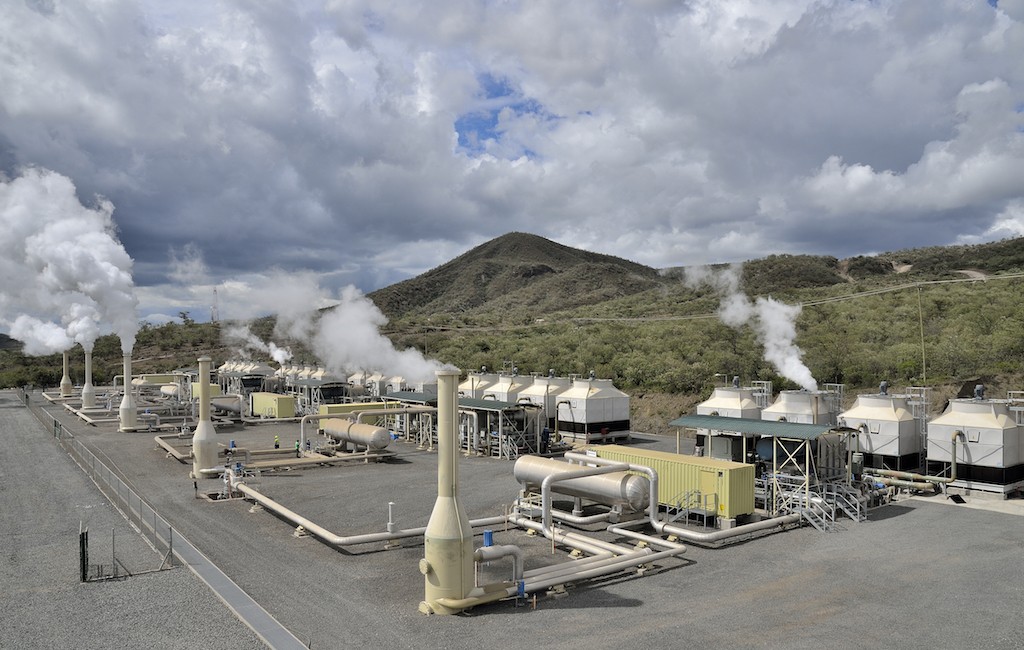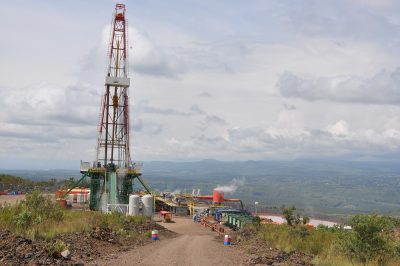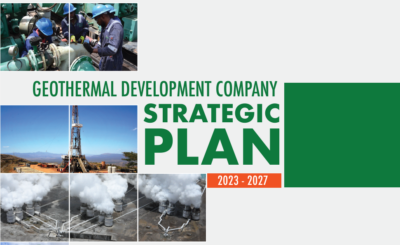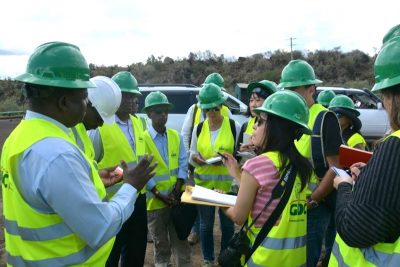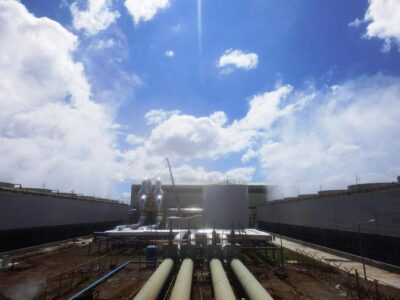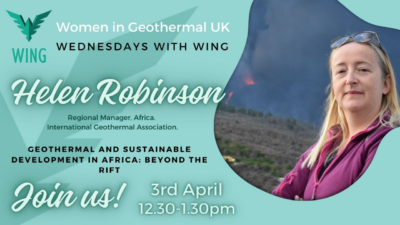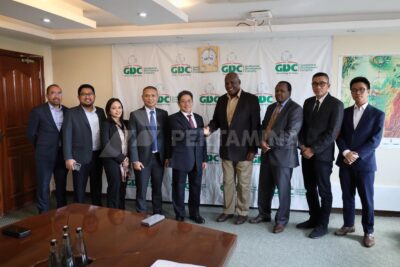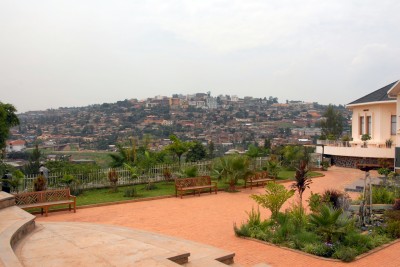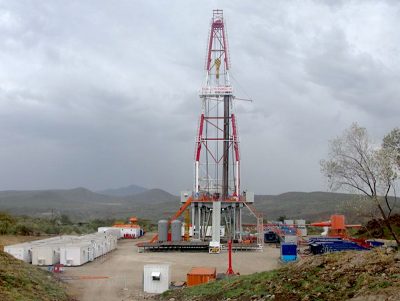Kenya’s journey towards geothermal leadership and model for African peers
This guest post by Tina Nduta provides an insight into geothermal development in Kenya, and how the country serves as a role model for further geothermal development through out Eastern Africa.
In this guest post, Tina Nduta (LinkedIn), Founder at Extractives & Energy Network Africa (EENA) gives us a featured overview on “Kenya’s Journey to become a top world geothermal producer and benchmark model for skill, capacity and technology to other African Countries.”
Introduction – What is geothermal energy?
Geothermal energy is the natural heat based within the earth’s crust. The energy is manifested on earth’s surface in form of fumaroles, hot springs and hot altered ground.
To extract the energy, wells are drilled to tap the steam and water at high temperature (250 -350 degrees Celsius) and pressures of (600 – 1200 psi) at depths of 1 to 3 kilometers. For electricity generation, the steam is piped to a turbine, which rotates the generator to produce electrical energy.
Geothermal power is uniquely ideal because it’s base load, it’s a renewable fuel so it does not emit carbon to the atmosphere, and is one of the most affordable forms of renewable energy.
Geology
The rift valley, for most, that reference perhaps only resonates with the spectacular view of the great rift view near Mt. Longonot, or a reference to a Province in Kenya. But the association of this spectacular geological feature to a world class geothermal resource largely goes un-noticed.
East Africa Rift System is associated with worldwide oceanic rift systems of over 30 – million years ago. These rifting events resulted to tectonics shifts and Volcanism and Geothermal activity is associated with occurrence of Quaternary Volcanoes located within the axis of the Rifts.
Kenya’s Exploration Journey
Exploration of geothermal resources in Kenya began in 1950’s and gained momentum in the 1960’s, when two wells were drilled in Olkaria. From 1967 the United Nations Development programme (UNDP) in collaboration with Kenyan government and the Eastern Africa Power and Lighting company ltd conducted geological and geophysical surveys in the areas between Lake Bogoria and Olkaria. These studies identified Olkaria as being the most prospective area – leading to the construction of the first geothermal power station between 1981 and 1984 – Olkaria I.
Olkaria I power station became the first geothermal power plant in Africa and has 45 MW in installed capacity. Olkaria II (105mw) had been drilled between 1986 to 1993 but construction of the power plants was delayed until the year 2000 when funds became available. The power station was commissioned in 2003. Then Olkaria I Units 4 & 5 each generating 140 MW were commissioned in December of 2014 and February of 2015 respectively.
Olkaria V’s construction was commissioned in January of 2017. The plant features two units with capacity of 82.7 MW each (total 165 MW). The plants started commercial operation in 2019. In addition to the power plants Kengen also has geothermal wellheads in Olkaria and Eburu. Olkaria well head generation plants have a capacity of 82 MW.
In total portfolio, Kengen owns seven larger geothermal power stations – Olkaria I, Olkaria II, Olkaria IV, Olkaria V and Olkaria I units 4 & 5, in addition to the well heads generation plants in Eburu and Olkaria. Bringing the entire portfolio to 707 MW. Olkaria III has 150 MW installed capacity is owned and operated by Ormat technologies.
The East Africa rift system has geothermal potential 15,000 MW – of which has Kenya boast an estimated 10,000 MW of that.
Development and enabling framework
Kenya has Conducive Energy policies and this is one of the attributes to the country’s rapid energy proliferation in recent years. Kenya was the one of the first countries to liberalize its power sectors, having allowed Independent power producers (IPPs) to operate since the 1990’s. One of the key policies that have accelerated the pace of investment in Kenya’s renewable energy was the Feed in Tariff (FiT) that was introduced in 2008 in line with the Energy Act 2006 – that has now been replaced by the new energy Act 2019. The FiT policy instrument allowed the IPPs to sell renewable energy generated to an off-taker at a predetermined tariff price.
As for geothermal specifically, Kenyan government in 2008 formed Geothermal Development Company (GDC), a state-owned corporation and special purpose institution to undertake geothermal exploration and steam development. By so doing Kenya achieved two critical objectives, one of it is that, it separated the functions of geothermal power generation (leaving that to KenGen), whilst geothermal development company limited (GDC) focused on exploration and resource development.
The other aspect of it, is that through geothermal development company (GDC) the government developed a model where through taking over exploration and steam development, it takes away the risk that many investors aren’t willing to take, allowing investors to come in at a later more proven stage of geothermal development.
Geothermal exploration is capital intensive, drilling for a 50mw well cost a circa USD 30 million at testing phase, that takes three years and a further USD 150m for full scale development that take another 4 years. Once the well is developed it could be operational for up to 40 years. It takes a tariff of between USD 6 cents to 10 Cents per kwh to break even for geothermal power
Along the way Kenya has had tremendous support from bilateral development partners. United States Agency for International Development (USAID) has been assisting Kenya with technical development whereas United Nations has been instrumental in facilitating training of our engineers through The United Nations geothermal training programme. World Bank, Africa Development Bank, European Investment Bank (EIB), Japan International Corporation Agency (JICA), French Development Agency (AFD) German Development Agency (KfW) have been Finance Partners.
Advancement in geoscience and other engineering technologies in recent years has also accelerated the rate of geothermal development to a certain degree.
Impact of geothermal power to Kenya’s economy
By 2004 Kenya had an Installed energy capacity of 1,239 MW – of which 677 MW (55%) composed of domestic hydropower, 125mw geothermal (10%), Oil fired thermal at 407 MW (33%) and 30mw of imported hydropower (2%). The corresponding effective capacity of 111.2mw, under normal hydrology against a peak of 821 MW. However, the, under adverse weather circumstances such as the 2000 drought, the effective capacity of hydropower at the time would be reduced to 639 MW or worst case 501 MW which even when combined with thermal power would not meet the 850 MW (2004-2005) peak demand.
Fast forward to 2018, Geothermal Power has overtaken hydropower as the lead Power source contributing more than 46%, reducing hydropower to 27% which has made Kenya’s energy Climate resilient, while Oil – fired thermal has been reduced to 24% , with tremendous impact to environment, other fuels including Solar, wind and imports account for 3% of Kenya’s energy source. As of 2020, geothermal actually represents more than 50% of the electricity generated in Kenya.
It is estimated that geothermal has lowered cost of power by 22% and 35 % for domestic and Industrial consumer respectively. Geothermal has also had profound environmental impact.
In 2014 GDC launched it’s blue print development strategy. In the strategy GDC put out Projections of installing 12 rigs and drilling at least 1,200 wells by 2030. GDC has geothermal prospect in Olkaria, Menengai, Paka, Silali and Bogoria.
From this development programme, GDC has developed 170 MW in steam capacity in Menengai, where a phased based implementation of the programme is underway. Under phase I development, three power plants of 35 MW each (105 MW total) are being developed by three EPC companies, namely OR Power, Quantum and Sosian.
GDC is also separately developing its Bogoria – Silali and Suswa Concessions. GDC also sells 320 MW of steam from its Olkaria Concession to Kengen. The other programme that GDC is undertaking a direct use programme that will used brine for heating, avail water and other products for Industrial use. This Programme is a first of its kind in Africa and it will benefit tourism by pool and spa heating, agriculture in greenhouse heating, milk pasteurization, cereals drying and such other facilities.
Benchmarking Kenya as for Skill Capacity and Technology transfer
Other countries with geothermal programmes are actively aligning and engaging with Kenya as a partner in geothermal development. In 2018, Djibouti’s Minister for Energy & Natural resources toured Menengai’s geothermal site where he affirmed of bilateral relations between the countries. Djibouti’s geothermal engineers have been trained at Menengai Centre of Excellence.
In 2019 Kengen was awarded a Contract to drill geothermal wells in Tulu Moye project Ethiopia. Under this Contract Ken- gen will drill 8 geothermal wells and provide Geoscientific survey. This benchmarks and the State owned generating company as the ideal Partner for Geothermal development to up eight Africa states that are various stages of geothermal development. These Countries Include; Uganda, Tanzania, Djibouti, South Sudan, Sudan Zambia and Comoros.
This Paradigm shift cements Kenya’s Position as the ideal skill capacity and technology partner to other Africa Countries beyond being a world class geothermal power producer.
Conclusion
UNEP’s Africa Rift geothermal conference ( ARGeo C8) takes place starting from 2nd to 6th November – 2020. The virtual conference is hosted under the auspice of Ministry of Energy Kenya, United Nations Environment programme (UNEP), International geothermal association (IGA) and other partners. This forum will focus on geothermal Investment for sustainable development.
Promoting geothermal cooperation between Kenya, that has had a successful geothermal programme and the other Africa states that are developing similar programmes will also feature in the programme.
We thank Tina Nduta for sending in this article.
